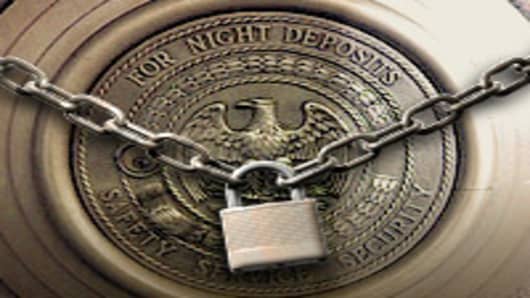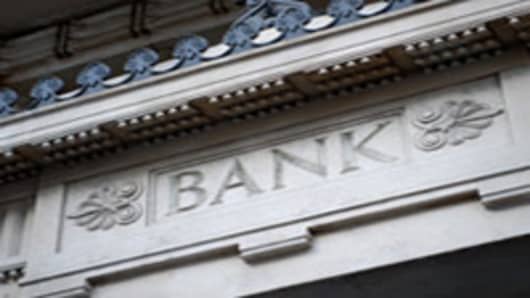Despite continued improvement for the banking industry as a whole, third-quarter regulatory data indicates the accelerated pace of bank failures will hold up for at least two more quarters.
Based on preliminary third-quarter regulatory data supplied by SNL Financial for roughly 93% of the nation's 7,700 banks and savings and loan associations, 155 were undercapitalized according to the regulatory guidelines that apply to most institutions.
The number of undercapitalized institutions has declined only slightly from last quarter, even though 21 banks have failed since the second-quarter list was pulled on September 7.
The third-quarter list is also likely to grow once the remaining regulatory data becomes available.
Another thing to consider is that any capital raised by institutions during the fourth quarter of 2010 will not be reflected in current results.
Most banks and thrifts need to maintain Tier 1 leverage, Tier 1 risk-based and total risk-based capital ratios of at least 5%, 6% and 10% to be considered well-capitalized under regulatory guidelines. Some trust banks carry lower capital requirements. The ratios need to be at least 4%, 4% and 8% for most to be considered adequately capitalized.
Seven of the banks on the Watch List were actually negatively-capitalized as of September 30. The largest of these was First Commercial Bank of Florida, which is headquartered in Orlando and had $599 million in total assets as of September 30 after posting a third-quarter net loss of $15.8 million was left with a Tier 1 capital ratio of -1.60%.
The bank's ratio of nonperforming assets — including loans past due more than 90 days or in nonaccrual status (less government-guaranteed balances) and repossessed real estate — to total assets was 21.80% as of September 30, more than double from the previous quarter.
The three largest banks on the Watch List last quarter have sufficiently improved their capital ratios to be excluded from the third-quarter list:
1. Sterling Savings
The largest bank on last quarter's undercapitalized bank list was Sterling Savings Bank of Spokane, Wash., which had $10.3 billion in total assets as of September 30 and is held by Sterling Financial .
Sterling Bank improved to well-capitalized as of September 30, with a Tier 1 leverage ratio of 10.19% and a total risk-based capital ratio of 16.77%, following the holding company's completion of its $730 recapitalization in August, which included large issuances of common shares to private equity investors Thomas H. Lee Partners and Warburg Pincus LLC and the conversion of $303 in preferred stock held by the U.S. Treasury Department for bailout funds received through the Troubled Assets Relief Program, or TARP, to common shares.
On August 2, Sterling Financial's other bank subsidiary, Golf Savings Bank of Mountlake Terrace, Wash. was merged with Sterling Savings Bank. Golf Savings had $564 million in total assets as of June 30.
Sterling Savings Bank's level of problem loans is still quite high, but asset quality improved a bit from the previous quarter. The nonperforming assets ratio was 9.23% as of September 30, compared to 10.02% the previous quarter and 6.53% a year earlier.
The bank posted a net loss of $40.3 million during the third quarter, with net charge-offs — loan losses less recoveries — totaling $83.7 million. Sterling Savings Bank's provision for loan losses was $66.6 million, meaning that the bank "released" $17.1 million in loan loss reserves. This followed the trend for the largest U.S. bank holding companies, with loan loss reserves at Citigroup declining $2.5 billion during the third quarter, while Bank of America and JPMorgan Chase both released $1.7 billion in reserves, Wells Fargo released $645 million and PNC Financial released $105 million in reserves, according to data supplied by SNL Financial.
Sterling Savings Bank's annualized ratio of net charge-offs to average loans during the third quarter was 5.02%, while loan loss reserves covered 3.99% of total loans as of September 30. While the reserve ratio was "behind the pace" of charge-offs, the bottom line is that the large capital raise provided considerable breathing room.
On September 27, state regulators and the Federal Deposit Insurance Corp. lifted a cease and desist order placed against the bank in October 2009, in light of the capital raise and, efforts to "reduce the proportion of its loans and other assets classified as non-performing as well as measures taken by the Bank to realign its credit practices going forward," according to a statement by the holding company.
2. Hanmi Bank
Hanmi Bank of Los Angeles also dropped from the Watch List after holding company Hanmi Financial raised a net $116.3 million in common equity during July, of which $110 million was down-streamed to the bank. The bank's Tier 1 leverage ratio was 8.26% and its total risk-based capital ratio was 11.61% as of September 30.
The holding company also expects to complete a deal to sell about $210 million in common shares to Woori Financial Holdings, which is based in Seoul, South Korea.
Hanmi Bank had $2.96 billion in total assets as of September 30 and reported third-quarter net loss of $13 million. The nonperforming assets ratio was 6.90% as of September 30, compared to 8.75% in June and 5.37% in September 2009. The bank's third-quarter net charge-off ratio was 3.44% and loan loss reserves covered 7.35% of total loans at the end of the third quarter.
3. AnchorBank, FSB
Third-quarter financial results weren't yet available for AnchorBank, FSB of Madison, Wis., or the thrift's holding company Anchor BanCorp Wisconsin , as of Thursday, however, the holding company previously announced that "based on the bank's internal financial reporting its capital ratio improved to 8.05% Total Risk Based Capital Ratio as of July 31, returning it to 'adequately capitalized' status and continues to be supported by a strong liquidity position, which exceeded $470 million as of July 31, 2010."
On the holding company level, Anchor Bancorp previously reported being in a negative capital position, with a June 30 book value of negative $3.95 a share.
On September 7, the holding company announced that AnchorBank had received conditional approval of its capital restoration plan from the Office of Thrift Supervision.
Capitol Bancorp: A Dubious Honor
Capitol Bancorp of Lansing, Mich. is the only bank holding company with multiple subsidiaries on the Bank Watch List, including eight subsidiary banks in six states. The holding company had 62 separately-charted bank subsidiaries in 17 states at the end of 2009, and has reduced the number of subsidiaries to 25 this year, through sales of some subsidiary banks and mergers of others. As of June 30, Capitol Bancorp had 33 bank subsidiaries. The holding company's Tier 1 leverage ratio was 2.39% and its total risk-based capital ratio was 6.38% as of June 30.
A company spokesperson told TheStreet on Friday that Capitol Bancorp expects to announce its third-quarter results "within a week and a half."
______________________________
Disclosures:
TheStreet's editorial policy prohibits staff editors, reporters and analysts from holding positions in any individual stocks.
______________________________
CNBC Data Pages:
______________________________



